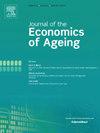The macroeconomic impact of chronic disease in the United Kingdom
IF 2
3区 经济学
Q2 DEMOGRAPHY
引用次数: 0
Abstract
This paper examines the macroeconomic impact of chronic disease in the United Kingdom (UK). We use individual-level data to estimate how diagnoses of six major diseases affect labor market transitions and combine these with a tractable growth model with age-specific productivity and labor force participation to quantify the impact of chronic disease on UK economic growth. Using a novel machine learning approach to classify National Health Service (NHS) cost data, we also provide new estimates of disease-specific treatment costs. Our findings indicate that a 20% reduction in disease incidence would increase annual GDP by 0.99% after five years and 1.51% after ten years. Most of the gains are due to increased participation in the labor force, especially among workers aged 50 to 65 years. Reductions in mental health conditions and musculoskeletal conditions contribute the most to these effects. Our analysis points to three important features of preventative health policies: (1) the potential welfare gains are substantial and manifest themselves in terms of both improved population health and increased output growth, (2) only around 40% of long-term effects appear after five years, and (3) the 50–65 age group experiences the largest labor force participation gains. This last feature is due to two factors: improved health at those ages prevents transitions into health-related inactivity and a larger share of workers reaches this age band as a result of reduced transitions into inactivity at earlier ages. This compounding effect underscores the importance of targeting prevention efforts at earlier ages.
英国慢性病的宏观经济影响
本文考察了英国(UK)慢性病的宏观经济影响。我们使用个人层面的数据来估计六种主要疾病的诊断如何影响劳动力市场转型,并将这些数据与具有特定年龄生产率和劳动力参与率的可处理增长模型相结合,以量化慢性病对英国经济增长的影响。使用一种新的机器学习方法对国民健康服务(NHS)成本数据进行分类,我们还提供了对特定疾病治疗成本的新估计。我们的研究结果表明,疾病发病率降低20%,5年后将使GDP年增长0.99%,10年后将使GDP年增长1.51%。大部分增长是由于劳动力参与率的提高,尤其是50至65岁的工人。精神健康状况和肌肉骨骼状况的减少对这些影响贡献最大。我们的分析指出了预防性健康政策的三个重要特征:(1)潜在的福利收益是巨大的,并且在改善人口健康和增加产出增长方面表现出来;(2)五年后只有大约40%的长期效果出现;(3)50-65岁年龄组的劳动力参与率增幅最大。最后一个特点是由于两个因素造成的:这些年龄阶段的健康状况改善,防止过渡到与健康有关的不活动状态;由于较早年龄阶段过渡到不活动状态的人数减少,达到这一年龄阶段的工人比例增加。这种复合效应强调了在早期阶段针对预防工作的重要性。
本文章由计算机程序翻译,如有差异,请以英文原文为准。
求助全文
约1分钟内获得全文
求助全文
来源期刊

Journal of the Economics of Ageing
Multiple-
CiteScore
4.10
自引率
4.50%
发文量
46
审稿时长
49 days
期刊介绍:
The Journal of the Economics of Ageing (JEoA) is an international academic journal that publishes original theoretical and empirical research dealing with the interaction between demographic change and the economy. JEoA encompasses both microeconomic and macroeconomic perspectives and offers a platform for the discussion of topics including labour, health, and family economics, social security, income distribution, social mobility, immigration, productivity, structural change, economic growth and development. JEoA also solicits papers that have a policy focus.
 求助内容:
求助内容: 应助结果提醒方式:
应助结果提醒方式:


